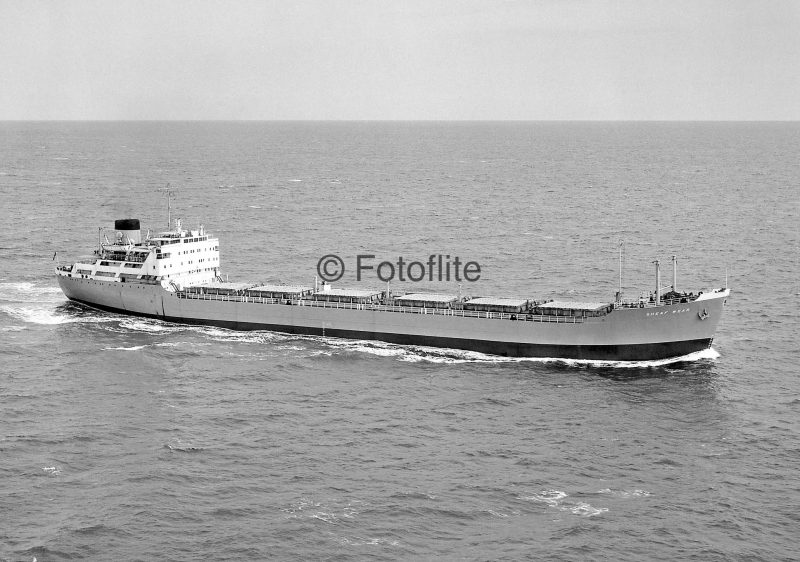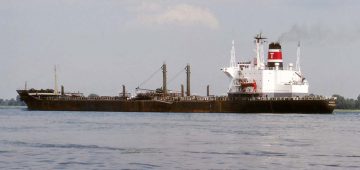The Sheaf Wear – Part One

 The sky was dark and threatening as a bitter wind swept across the rolling sea, and I shivered and pulled my coat around me as the first drops of icy rain began to fall.
The sky was dark and threatening as a bitter wind swept across the rolling sea, and I shivered and pulled my coat around me as the first drops of icy rain began to fall.
It was late Autumn, 1969 in the Port of Leith, and I gazed across the grey Firth of Forth at a laden freighter lazily making her way down-river and wondered. “Where was she bound? Where had she been? What was her cargo? Who were her crew?”
I was 21 years old and just completed my apprenticeship as a Fitter and Turner, and in the halcyon 1960s a trade background in heavy engineering could give you access to joining the Merchant Navy as an Engineer Officer, and oblivious to the falling rain, I dreamily watched the ship disappear with only a wisp of smoke as evidence of her passing and made a decision, a decision which inadvertently was to change the whole course and direction of my life. I was going to join the Merchant Navy as an Engineer.
But where to start?
The British Shipping Federation had established a ‘pool’ in the major ports around the U.K. where shipping companies could ‘advertise’ and employ men to crew their vessels, and as one such place existed in Leith, I made arrangements to register for an interview and assessment. Every person had to be graded according to their engineering background, and an ideal applicant from a shipyard would be classified as an ‘A Grade’ prospect, ranging to motor or even a sewing machine mechanic at the other end of the scale.
I was given a ‘B Grade’ classification suitable for employment as a Junior Engineer, and after a successful medical examination I returned to the ‘pool’ with my vaccinations completed and clutching a new Seaman’s Record Book.
“Well!” a friendly clerk greeted me as he checked my paperwork. “You’re all set and ready to go, but where to? India, Africa, Australia, I’ve got it all here…. or how about a ‘Runciman’ tramp as they go everywhere!”
I had no idea what he was talking about, but smiled. “It’ll be my first trip, so maybe somewhere not too far or very long away!”
“Then I’ve got just the thing,” he mused. “How about Liverpool to Canada and back, around four weeks all up, maximum!”
It sounded perfect, and it only took a single telephone call for him to secure me the position of Junior Engineer, and after he’d explained some of the finer details I turned around to walk away when he called out after me. “Good luck!”
The ‘Sheaf Steam Shipping Company’ were to be my new employers, and established in 1906 by William Albert Souter they operated a small fleet of iron-ore,and bulk carriers from their Newcastle headquarters, and in due course I received a rail travel voucher and instructions to join one of their vessels. Liverpool was one of the busiest ports in the country, and as the taxi swept past an array of ships I searched for my new home, until we came to a halt beside the motor vessel, ‘Sheaf Wear’.

I gazed upwards at a sheer, rust streaked grey hull and her overall size looked impressive, but was later to learn that she was just an average sized ore-carrier of 10,867 gross tons, and one of two sisters built in 1959 at the ‘Laing’ shipbuilding yard in Sunderland and registered in Newcastle. So, with a suitcase in one hand and a hastily tailored uniform balanced in the other, I struggled up the gangway before a burly seaman bounded down to assist, but when my lowly rank was discovered, and a ‘first tripper’ no less, he had no more interest and unceremoniously dumped my luggage at the bulwarks and pointed me in the general direction of the ship’s office.
“They’ll help you there, mate!”
I looked around, until another person inquired what my purpose was, and I eventually stood before the Master and ship’s agent who were conducting the signing on, and my name was checked-off and Seaman’s Record Book stamped.
“Just joined ‘Souters’, and first trip?”
“Yes, Sir!”
The Captain raised his head as I scribbled down my signature. “Welcome aboard, lad. Just listen, learn and do what you’re told, and everything’ll be fine.”
The Duty Engineer was summoned, and my baggage hurriedly thrown into my cabin before he chirpily introduced himself. “I’m Steve, Fourth Engineer, and I’ll show you below.” His Geordie manner was friendly and enthusiastic as he gave me an introductory tour, and to anyone who has never visited a ship’s engine-room before, its first impression is both impressive and intimidating.
We descended into a brightly lit interior, and I gazed at a maze of ducts and pipes before climbing down three levels to stand at a control console where I was surrounded by more pipes, valves, pumps, dials and gauges, and a panel of red, green and white lights winked their mysterious messages towards me. There was a steady hum as a single generator ran, and I looked up in awe at the mighty ‘Doxford’ main-engine that stood as high as two houses, and Steve smiled at my expression. “She’s big, isn’t she…. and you’ve never been to sea before, have you?”
“Is it that obvious?”
“It’s all a bit daunting at first,” he grinned. “But you’ll soon get used to it!”
The engine-room was spic and span, and I discovered that as well as British Officers, deck and catering crew, the ‘Sheaf Wear’ carried Arab firemen, and greasers whose job it was to keep the area clean and machinery lubricated, and Steve advised me. “And don’t ever whistle when they’re around. It’s an Arab superstition that the little wind blows up a big one and brings bad luck to the ship, and they hate it.”
We made our way upwards, and as I stood on the top-plates beside the main-engine’s motionless cross-members, I stared at a neat stack of rings more than three feet in diameter as Steve informed me. “They’re spare piston rings.”
“Spare piston rings,” I muttered. “I thought they were metal hula hoops!”
We continued on our tour, and Steve took me to the Officers’ smoke-room and empty dining saloon, and I peeped in at the crisp white linen on neatly arranged tables as he advised me. “Dinner starts at six o’clock, and the food’s not too bad!”
“Should I wear my uniform?”
He eyed my well pressed trousers and conservative sports jacket before shaking his head. “We’re pretty casual and you’ll be fine like that.” before adding as an afterthought. “The ‘Old Man’ and Chief tart themselves up a little bit sometimes, but I haven’t even bothered to bring the old ‘doeskin’ with me this trip!”
“I’ve got to go below,” Steve continued. “But I’ll be off duty soon, and there’s a nice wee pub up the road if you fancy a couple of quiet pints later on?”
I nodded enthusiastically. “Sounds like a good idea to me!”
So, with a little time to myself, I explored the ‘Sheaf Wear’ from stem to stern and my first observation was that her decks were barren with no cargo handling facilities, except for two Samson posts mounted on the forecastle above the Bosun’s store, and with all of her six cargo holds forward of the white superstructure she obviously had to rely on shore equipment for loading and discharge. And as darkness fell, I watched the Red Ensign being lowered from the stern flagstaff, and floodlights were turned on to illuminate a large, yellow wheat sheaf emblem mounted on a broad blue band that circled the ship’s black funnel.
I returned to my cabin and was pleasantly surprised at the tasteful blue decor, single bunk, day-bed and writing desk, and there was a small wash basin with hot and cold running water, whilst the toilet and showering facilities were shared in a communal bathroom with other Engineers where I freshened up before dinner. And my evening meal was another pleasant surprise as a hearty vegetable soup was offered as an entree, followed by grilled beef with jelly and cream for desert.
The ‘Sheaf Wear’ carried seven Engineers with watch keeping duties carried out by the 2nd, 3rd and 4th Engineer assisted by their Juniors, and the 2nd Engineer stood the 4-8 watch, the 3rd Engineer the 12-4 and the 4th Engineer the 8-12, whilst the Chief Engineer didn’t stand a watch, but was ‘on call’ at all times. Sea-watches were to start at midnight, and the traditional British system of four hours on duty and eight hours off duty was worked, and I was allocated the 8-12 watch with Steve, which meant an 8am start finishing at noon then returning for duty at 8pm.
My first voyage was to commence the next morning sailing in ballast to Sept Iles, a port at the mouth of the St. Lawrence river in eastern Canada to load a full cargo of iron-ore before returning to the U.K. and I was advised to have an early night, but not heeding the advice, it was soon time to go ashore.
We ambled up the road heading towards the little bar and easily settled into the snug, chatting about our different backgrounds and hopes for the future, and the couple of quiet pints quickly turned into four, then six, and when Steve spotted some old shipmates from a previous ‘Souter’ ship he called them over, and with Liverpool at our fingertips, we all hit the town….
“Stand-by, mate!” I heard in the distance, as a heavy hand shook me roughly on the shoulder to awaken me from a deep sleep. I focussed with difficulty to make out the blurred image on my watch which indicated it was barely six o’clock, and grumbled. “Go away!”
“Cummon, fella, you’re on stand-by in ten minutes.”

And with little choice I forced myself to wake and wrestled into my new, white overalls and stumbled towards the engine-room, but it was a vastly different world that greeted me from the very casual introduction I’d had the day before as the noise, heat and stench of diesel hit and almost overwhelmed me.
Two generators were running, two compressors were running, the oil separators were running, the fuel pumps were running, and as I struggled down the steel ladders a huge blast of air expelled indicating that the main-engine had just been ‘turned-over’. My stomach did the same, and when I reached the bottom-plates I was greeted by a solid, balding figure who looked at me inquisitively.
“Hello, I’m Tom, Second Engineer…. are you alright?”
I nodded half-heartedly, and returned his firm handshake as I mumbled my own introduction.
“Jesus!” he exclaimed, and pulled back sharply as I breathed over him.
“How much did you have to drink last night?”
“Nine pints!” I miserably replied.
“Is that all, couldn’t you have squeezed in ten?”
“I did, but I lost it somewhere…. along with some prawns and chicken chow mein!”
Tom shook his head, and stopped and stared as a very pale Steve slunk by with sunken and bloodshot eyes. “You young blokes will never learn, and you look worse than Jim does!”
We didn’t have the chance to speak, and I waited for an opportunity before taking Steve aside and asking. “What’s happened, I thought that my watch was eight until twelve?”
“It is, but we’ve two hours ‘stand-by’ either side every time we leave or enter port.”
I looked at him in dismay. “So I could be here until two in the afternoon?”
He nodded, and gave me a rueful grin. “Me too!”
And it was all a bustle of activity as the ‘Sheaf Wear’ was made ready to sail, but I had absolutely no interest or enthusiasm, and it must have shown as I was given the ‘Ship’s Movement Book’ to look after, and it was carefully explained to me in words of one syllable that I had to record the time and what engine movement was asked for when rung down from the bridge on the telegraph.
06.40 hrs. Stand-by.
06.45 hrs. Dead-slow-ahead.
06.47 hrs. Stop.
06.49 hrs. Dead-slow-astern.
And so it went on, but even this simple task was a difficult one in my delicate state, and as the ship left the sheltered dock and edged her way into a frisky River Mersey I immediately felt her movements, and the 2nd Engineer growled at me. “You look terrible. Get yourself top-side and have a decent breakfast!”
I made my way upwards and gulped thankfully at the fresh air and gazed back at the receding Liver Building, but had no desire for any food and shuddered at the sight of a plump pork sausage quivering in an oily sauce, and almost vomited as the aroma of frying bacon and eggs wafted towards me.
It was a dull and chilly morning, and a strong breeze was blowing up white crests on the choppy water as the ‘Sheaf Wear’ steamed down-river towards the Irish Sea, and I stayed as long as I dared before returning to the engine-room where I was introduced to the Chief Engineer, who couldn’t have cared less about me as he stood at the engine controls completely absorbed and staring at a huge dial that indicated the main-engine’s revolutions. Before we’d even moved he’d been in attendance, aloof and not interfering or becoming involved in any way, but armed with a torch and shifting spanner had strolled around and about, up and down, touching, looking and listening for any untoward behaviour in his beloved machinery.
“If it wasn’t so hot and moving so quickly,” Steve observed. “He’d probably try to f*** it!”
We bade farewell to the river pilot and headed into the open sea, and when ‘Full-sea-speed’ was called for, the 2nd Engineer and his Junior hastily departed leaving Steve to take control of the watch and instruct me on my engine-room duties and the routines involved. Temperatures and pressures were stabilized as the main-engine settled into its rhythm, and the oil separators stopped and air reservoirs topped up before the compressors and one generator shut-down, but not feeling any better all I wanted to do was find my bunk and lie down.
It seemed like an age before we were relieved at noon by the 3rd Engineer and his Junior, and the Chief was still hovering around the top-plates as we made our way onto a windswept deck to find a grey and rolling sea with Liverpool long gone, but a strong breeze blowing into my face refreshed me and I brightened up a little.
Shipping traffic was heavy and everything seemed to be passing our lumbering, 12 knot hulk, and we watched an elegant white reefer streak past before an elderly, but very dignified and immaculate ‘Uruguay Star’ also overtook us as Steve sighed. “Probably bound for sunny South America, lucky buggers!”
I wondered what he meant, and asked. “Is Canada that bad?” but he continued to stare at the disappearing ship, and didn’t answer.
Our voyage to Sept Iles wasn’t expected to be a pleasant one with gales and heavy weather forecast, but my thoughts hadn’t reached that far ahead and were only for the present as I forced myself to eat some boiled potatoes for lunch before eventually finding the sanctuary of my cabin, and I drifted in and out of a restless sleep missing dinner until the inevitable call came at 19.45 hours. “You’re on watch in fifteen minutes.”
The marine engine is a complex beast that needs to be pandered to at all times, and any illusions I’d had about just monitoring gauges and generally, ‘keeping an eye on things’ were quickly dispelled as it soon became clear that there was plenty of work to be done, but my lingering hangover had returned with a vengeance and I still had no interest or enthusiasm.
The writing of the engine-room logbook was itself a lengthy process as everything that occurred on watch had to be recorded in detail. What time the bilges were pumped, where the fuel-oils were taken from, which of the ship’s three generators was running and even the temperatures of its six cylinders were recorded, and I remarked to Steve. “But there’s two thermometers missing?”
“Don’t worry about that,” he glibly replied. “Just flog it!”
“What do you mean, ‘just flog it’?”
“Take an average,” he grinned at me. “It’s an ancient custom to, ‘flog the log’, and the Chief does it all the time!”
“Then what’s the point of taking it in the first place?”
“You’re a pedantic bastard, aren’t you!”
And it was a noon ritual to take the canvas covered logbook to the Chief Engineer’s office, where he would ‘adjust’ the smudged and grubby figures to his satisfaction before entering them into the ‘official’ logbook. “It’s actually called, ‘creative watch keeping’!” a Chief Engineer once told me as he carefully entered the altered details with a fine nibbed pen and cultured writing style…. and I was often to wonder if a Chief Engineer had a charter to write with finesse as a doctor has a license to scrawl as I was never to meet a Chief Engineer who would scribble.
We rounded the tip of southern Ireland, and with Mizzen Head far behind and steaming west into the Atlantic Ocean, the weather forecast was proven correct as we headed straight into a storm. Lashing rain and sleet battered our hull as a fierce wind blew the heavy swell into mountainous waves, and the ‘Sheaf Wear’ behaved like a rampant mare as she reared her head then poised, before crashing down into a cauldron of green sending the single screw and propeller clear of the water and racing out of control, until it was governed by the Engineer on watch.
Port holes were secured, and the steel doors leading onto the deck battened down as the shrieking wind and raging sea tossed us around at their whim, and it was forbidden to venture outside the accommodation for fear of being swept overboard. We made little progress, and with the empty vessel riding high in the water our living conditions were difficult with my own existence becoming a miserable one.


Comments
Sorry, comments are closed for this item